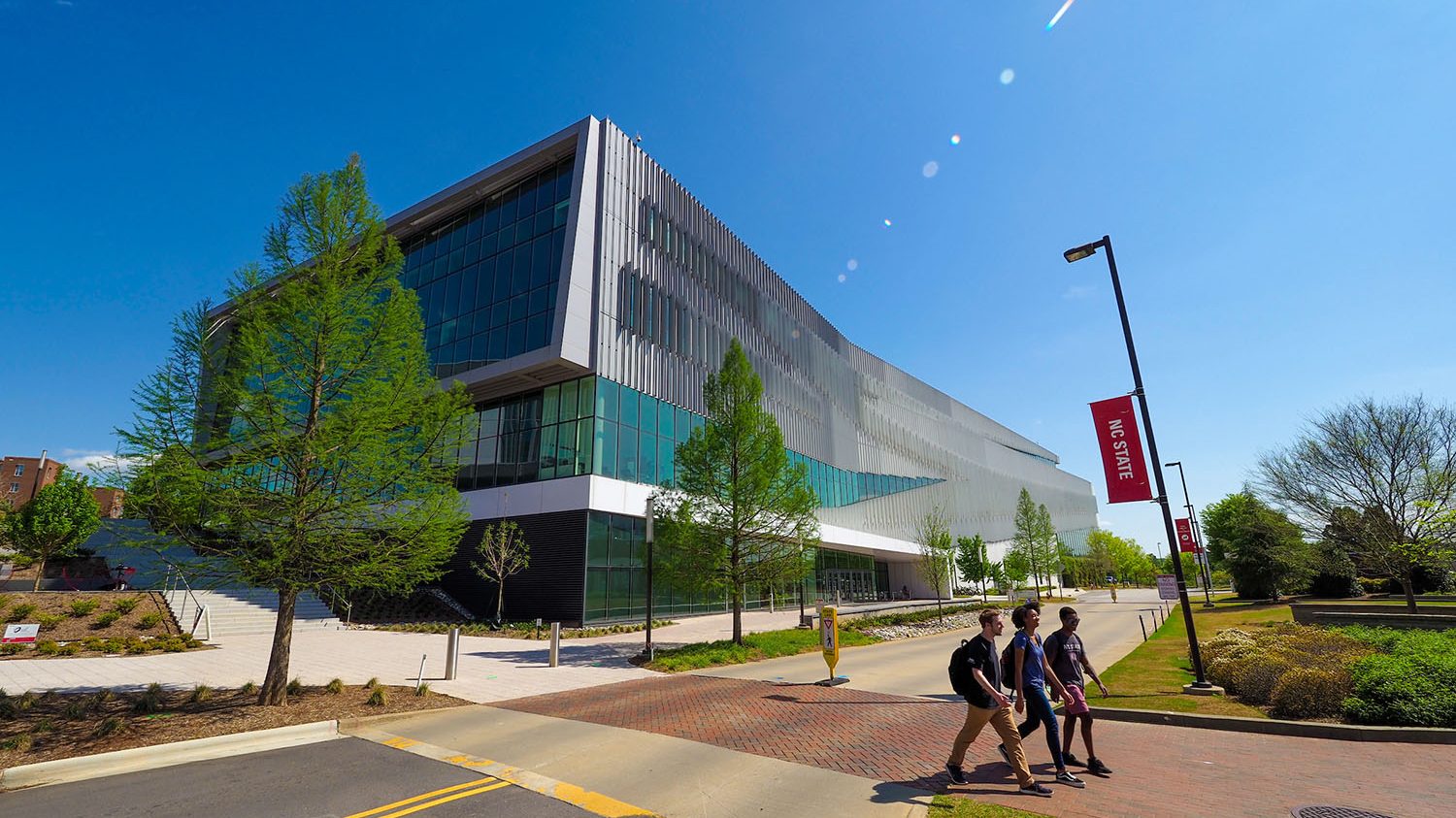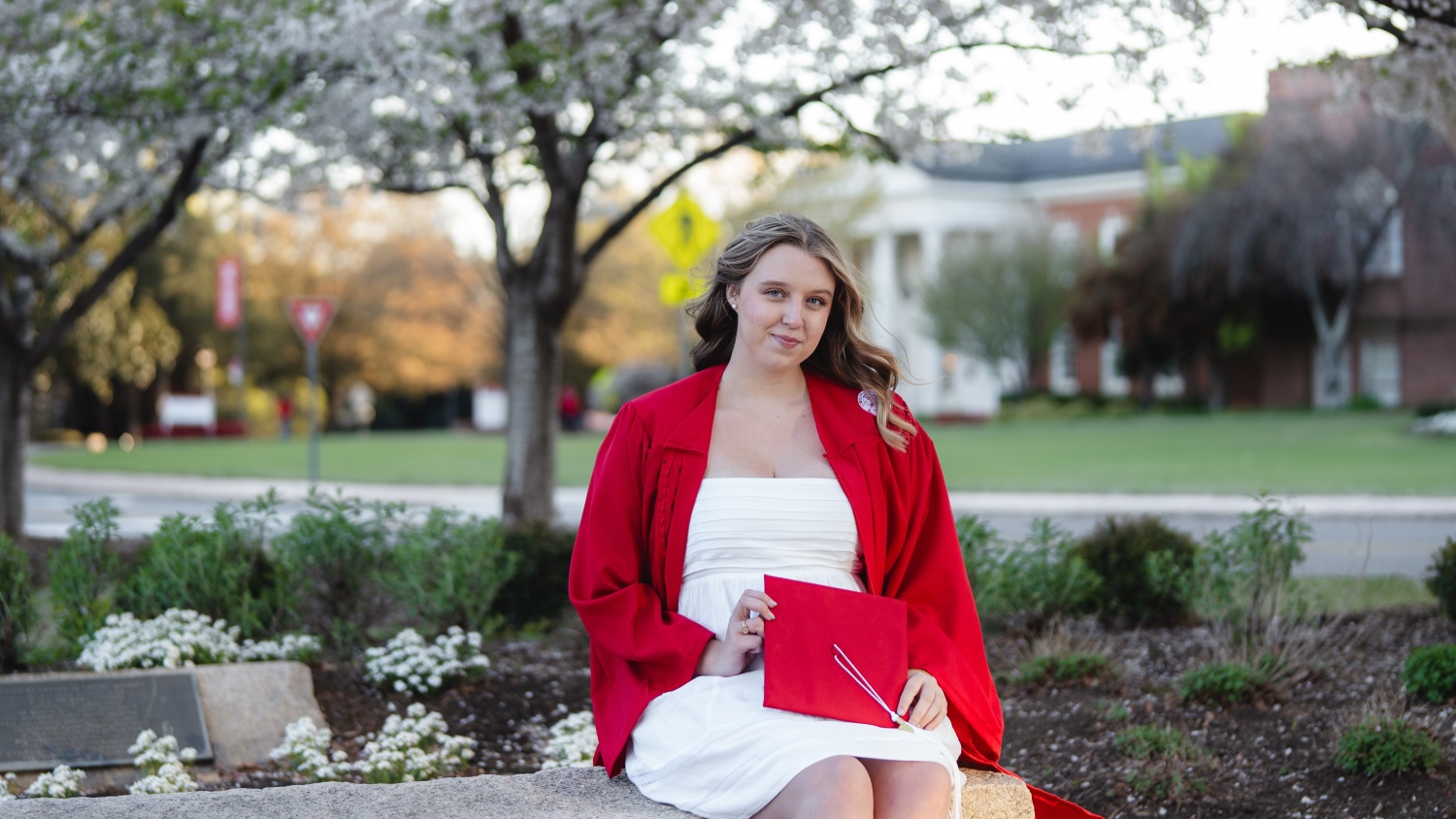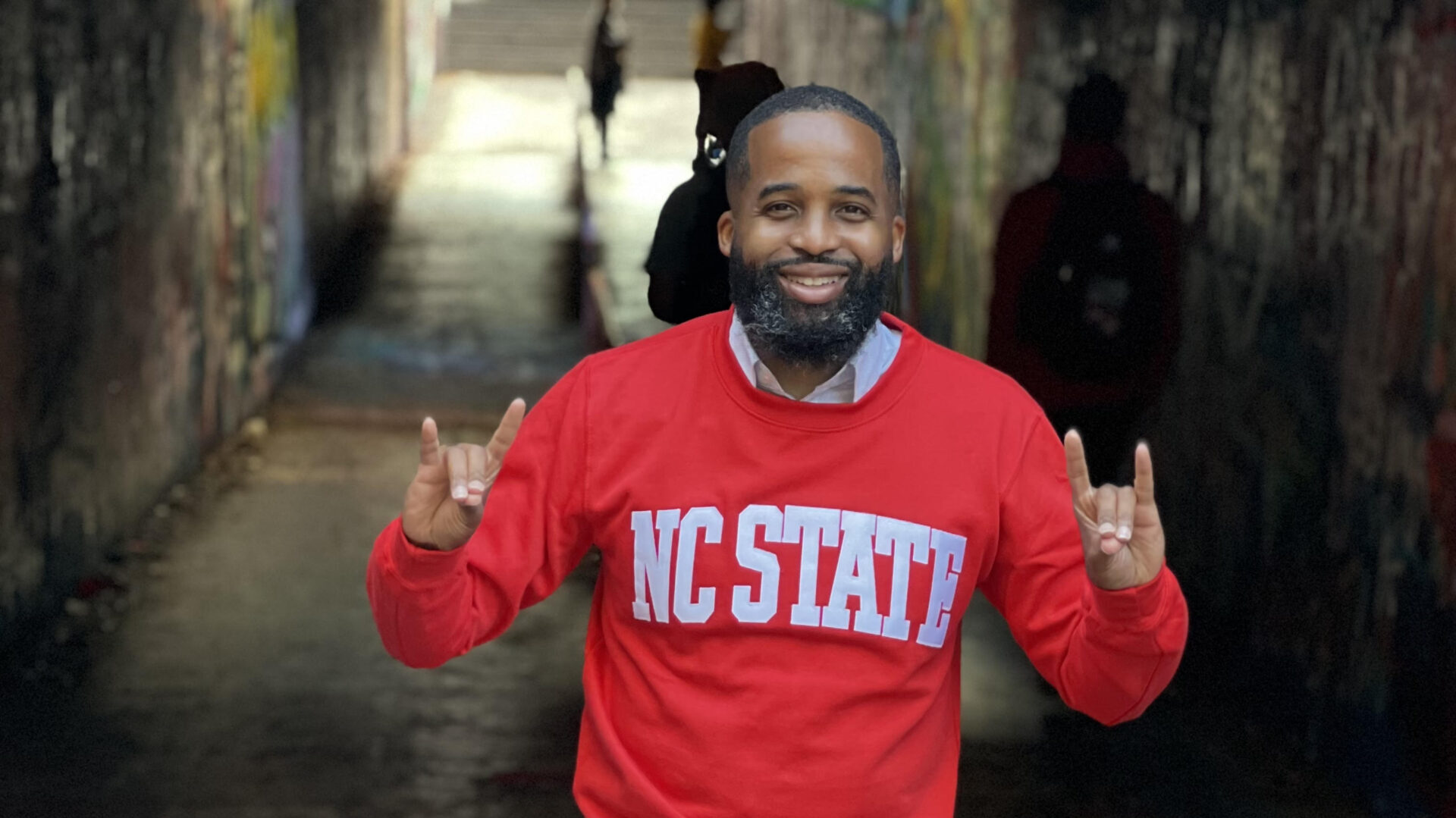As part of serving every Wolfpack student, NC State University Libraries is committed to alleviating the financial burdens that can stand in the way of higher education. Over the past several years, the COVID-19 pandemic deepened understanding of how important access to technology is to learning and the Libraries responded by growing its pool of resources — thanks to donor support.
We recently spoke to David Tully, librarian for student success and affordability, about the barriers some students face, the ways support from the Libraries helps students stay enrolled at NC State and the role of philanthropy in empowering students to succeed.
What role does the Libraries play when it comes to addressing student need?
David Tully: Student need for us, in terms of where we channel our resources, is focused upon textbooks and technology, especially laptops but also internet connections, which became very important very quickly during the period of remote work. We support those needs in a number of different ways. We are also heavily invested in textbook lending — our program predates me, and I’ve been here 10 years.
Often, when we talk about access and affordability, we’re talking about scholarships and getting students here. Can you explain why it’s important to support resources like technology and textbooks?
Tully: Getting here is one thing, staying here is quite another. We know from working with colleagues elsewhere that the highest attrition is among sophomores, not freshmen. In my experience, I have students who have underestimated the hidden costs of attending college and can face significant challenges to remain enrolled when unforeseen costs arise.
There are some students — usually around 10% of an incoming class — who come from households with combined incomes of less than $30,000 a year. That puts them in a precarious financial situation should they face rising or unexpected costs such as medical bills, a laptop breaking or a laptop unsuitable for the programs they are trying to run. These are the kinds of things that put a significant number of our students in a situation where access is really key.
Textbooks still cost around $1,000 a year — that’s what the Office of Scholarships and Financial Aid recommends for undergraduate budgets. That amount has gone down since last year, but it remains significant and a huge barrier.
And, of course, these days, it’s not just about having access to the course material. Bundled in with those materials are things like online access codes, which cost students extra money to access and, at times, to be able submit their homework. So, whereas in the past, students could choose not to buy a textbook and rely on the Libraries, now it’s, “If I don’t have it, my grade is going to be affected, my participation in class is going to be affected.”
Some materials cost up to $300, which, again, for some students is just an enormous hurdle to navigate.
We at the Libraries certainly see access to a laptop as a basic need. Students might not always budget for one, but we’ve seen over the last few years that laptops are actually an essential need, particularly for students who are offsite or don’t have the means to have transportation to come to the Libraries to borrow one or use one of our desktop computers.
What is the Libraries Student Resource Fund?
Tully: It’s a fund that is set up to support students who are in a particularly precarious position where they can’t necessarily afford the cost of these essential materials, such as textbooks and laptops. They can turn toward the Resource Fund as one avenue. Normally we learn about those students by referrals from Pack Essentials — students who have no other option in terms of participation and having means to succeed in school.
The Libraries Student Resource Fund is like a lifeline in a lot of ways for some of these students, because without it they wouldn’t have the resources to succeed.
Is this the primary way students can access materials for an extended period of time?
Tully: Yes, so what we can do with the Resource Fund is we can purchase laptops with private money, which is important because our lending laptops are paid for by the educational and technology student fees so we do not loan them on a long-term basis. These laptops are on loan for eight hours at a time typically.
But through philanthropy, we have more freedom to make something available for a longer period of time. We can check devices out for an entire academic year, as we’ve done with some students. We can really remove that burden of cost over a longer time period and allow them time and space where we hope they can save up or get themselves into a position where they can make a purchase themselves.
What might our alumni and friends not know about access and affordability for library materials you would want to share?
Tully: There are several things!
We have a robust technology lending program, which is fantastic and suits all sorts of needs, but, again, there are restrictions for lending technology longer term. So it goes some way toward meeting a need, but it doesn’t go far enough for a lot of our students, which is why philanthropy plays such an important role.
A lot of donors I’ve spoken to in the past are generally very surprised by the cost of materials these days. The cost has skyrocketed in recent years. Likewise, when I went to school, I didn’t have to pay to submit my homework or pay to access items behind a paywall I couldn’t otherwise access. Students find themselves in that situation now.
And generally speaking, these aren’t statistics we often broadcast, but it’s publicly available that 10% of students come from households with incomes under $30,000 a year, and I don’t think a lot of folks who aren’t working already in this space realize one in 10 of our incoming students comes from a background around the poverty line.
There are 5,600 students in 2022’s first-year class, so based on that measure, we have nearly 600 students arriving at NC State statistically very vulnerable to dropping out or taking much longer to complete a degree, therefore accruing more debt. Having access to these materials plays a huge role in ensuring they do stay on track – they’re able to stay and then graduate on time into successful careers. And through things like scholarships, there is a multi-generational impact. You’re supporting this student now, but what you’re really doing is supporting that student and their family down the line. You can play a significant role.
Can you explain what a homework code is?
Tully: It’s an access code, which is something we don’t have an answer to in our textbook lending or our ebooks — one code for one user. And that’s problematic for us at the Libraries, and a lot of e-texts now have it. These codes also kill the secondhand textbook purchasing model, which has been a lifeline for students. The publishers make this very attractive for instructors in terms of ease of grading, but for the student it’s not so great, because of the costs involved.
Could something like this shut a student out of a particular major — might they feel the need to pursue a discipline with less expensive materials?
Tully: There is data suggesting a significant number of students don’t take particular classes because of the costs involved. They’ll switch to another class that wasn’t their first choice or they’ll forget about taking the class entirely. So there is an unequal playing field created between those who can afford to fully participate and those who can’t.
You can imagine a student wanting to take a class and then not being able to, despite being an enrolled student at the university — that’s not really a great environment. I work quite heavily in open education, so part of my job is working with faculty to adopt or create OER (open education resources) as an alternative to the traditional textbook model.
There are instances where there have been some sections of a course with OER and there’s another section with a required $300 textbook. And it’s just luck of the draw which way a student falls in. I recently heard from a professor that there have been some students who have attempted to transfer their class because of the cost involved, which speaks volumes.
What challenges do you face in your role, working with student access and affordability?
Tully: That’s one of the biggest challenges, it’s fair to say. The alternative to this model usually demands faculty time, which is very precious. I have conversations with faculty who are fed up with the cost of the book they’re asking students to buy and are interested in another model such as OER, but because OER literally asks you to redesign your course in some ways, there’s a significant time commitment required, and for some folks that’s just not realistic.
And OER is well represented in the intro courses but not so much in some disciplines in the 300- and the 400-level courses. You might not have the existing material you can build upon, which is half the battle in some ways. Some folks may be starting from scratch, so one of the biggest hurdles is working around that.
We have the Alt-Textbook Project, which provides grants to faculty. They can apply on a semester basis, and we grant up to $2,500 to go some way toward addressing those issues. People use that for all different things — maybe hiring a graphic designer to work on the textbook they’re creating or adapting or hiring a grad student to do some of the heavy lifting. Certainly in terms of textbooks, that’s the biggest challenge.
In terms of technology, the biggest challenge is the amount of laptops we’re able to loan out at one time. We’ve made pretty good inroads into boosting the pool of laptops. Because of the Libraries Student Resource Fund, this past summer, we were able to purchase around 20 new laptops, which was a significant boost. We had five or six before, so now we’re at 25, which puts us in a really good position. What we’ve done through that is partner with some of the colleges to supplement some of their own need-based scholarship programs.
This is the inaugural year of the Transformational Scholars Program at the College of Education, for example, which is a need-based scholarship. We were able to partner with the college to provide a long-term laptop loan and textbook support for an entire year to ease that landing of coming into campus.
We do something similar with the College of Humanities and Social Sciences for their Impact Scholars. We tack on additional Libraries support with the programming and the monetary awards, and so on. It would be amazing if the Libraries Student Resource Fund was in a position to work with more of the colleges to do similar work because that has had a real impact over the last year.
What’s the most rewarding part of working in this space?
Tully: That’s never-ending, to be honest — just having an impact. Feeling like we’ve made even the slightest difference to a student’s ability to succeed is a really nice feeling. It’s really rewarding.
And at the Libraries, we really do care about student success. It’s the first goal of our list of priorities, our organizational mission, and being able to put some of that into practice thanks to philanthropy and working with like minded-people creates huge satisfaction. We can only take a shred of the credit because, ultimately, at the end of the day, all of it is down to the student; we’re just putting them in a position where they have the tools to succeed, where previously they didn’t. I think most students, when they have the tools, do succeed. Some just need a little bit of extra support, and that’s where the Resource Fund has such an impact.
How can donors continue to help make a difference at the Libraries in terms of access and affordability?
Tully: Certainly they can continue to support the Libraries Student Resource Fund. That’s the general fund for donations through annual giving. In terms of having a larger impact, moving into the major gift category, providing the financial support to buy more laptops in bulk would allow us to go to the colleges and figure out where we can have an impact with their scholarships.
And a laptop is great because it’s a one-time cost, so the impact repeats year after year after year, up until five or so years, when we’d want to refresh the technology.
In addition to continuing to support the Student Resource Fund, there’s our Libraries Student Scholarship Endowment. The scholarship fund is also really important. We’ve been looking to grow that since 2017, when we handed out our first awards. We employ about 250 students at any time, and they are outstanding. These are need-based scholarships, and it’s nice to be in a position where we are able to financially support our student workers. This year we handed out 10 awards totaling about $36,000. Our goal is to grow that significantly. Our initial awards were for two students, and again, thanks to philanthropy, we’ve gone from awarding about $4,000 to $36,000 five years later. Our next goal is to reach $50,000 in scholarships, and there’s a lot of work still to be done.
We provide some extraordinary learning opportunities. Students can gain experience in things such as customer service, web design and data visualization and lots more. There are so many real-life job experiences taking place at the Libraries that stand a student in good stead after graduation and make them more competitive in the job market. But a number of our students are not immune to those financial pressures we talked about, and we’ve had talented students who have dropped out because they’ve exhausted their financial aid.
A scholarship goes a long way toward helping them stay in school, continue to work for the Libraries and gain these experiential learning skills that position them well to graduate and have outstanding careers.
- Categories:



